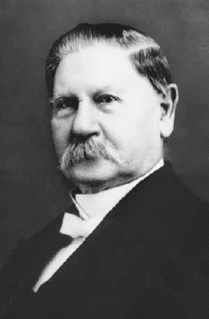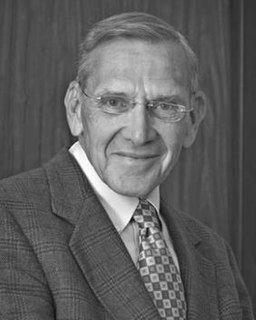
Alan Curtis Kay is an American computer scientist. He has been elected a Fellow of the American Academy of Arts and Sciences, the National Academy of Engineering, and the Royal Society of Arts. He is best known for his pioneering work on object-oriented programming and windowing graphical user interface (GUI) design. He received the Turing award in 2003.

Richard Errett Smalley was an American chemist who was the Gene and Norman Hackerman Professor of Chemistry, Physics, and Astronomy at Rice University. In 1996, along with Robert Curl, also a professor of chemistry at Rice, and Harold Kroto, a professor at the University of Sussex, he was awarded the Nobel Prize in Chemistry for the discovery of a new form of carbon, buckminsterfullerene, also known as buckyballs. He was an advocate of nanotechnology and its applications.

Charles William Penrose was a member of the Quorum of the Twelve Apostles of The Church of Jesus Christ of Latter-day Saints from 1904 to 1911. Penrose was also a member of the First Presidency, serving as a counselor to church presidents Joseph F. Smith and Heber J. Grant from 1911 until his death.

George Franklin Richards was a member of the Quorum of the Twelve Apostles of The Church of Jesus Christ of Latter-day Saints from April 9, 1906, until his death. He also served as Acting Presiding Patriarch of the LDS Church from 1937 to 1942 and President of the Quorum of the Twelve from May 25, 1945, until his death.

In political studies, surveys have been conducted in order to construct historical rankings of the success of the presidents of the United States. Ranking systems are usually based on surveys of academic historians and political scientists or popular opinion. The scholarly rankings focus on presidential achievements, leadership qualities, failures and faults. Popular-opinion polls typically focus on recent or well-known presidents.

Solomon Wolf Golomb was an American mathematician, engineer, and professor of electrical engineering at the University of Southern California, best known for his works on mathematical games. Most notably, he invented Cheskers in 1948 and coined the name. He also fully described polyominoes and pentominoes in 1953. He specialized in problems of combinatorial analysis, number theory, coding theory, and communications. Pentomino boardgames, based on his work, would go on to inspire Tetris.

Richard Lyman Bushman is an American historian and Gouverneur Morris Professor Emeritus of History at Columbia University, having previously taught at Brigham Young University, Harvard University, Boston University, and the University of Delaware. Bushman is the author of Joseph Smith:Rough Stone Rolling, an important biography of Joseph Smith, progenitor of the Latter Day Saint movement. Bushman also was an editor for the Joseph Smith Papers Project and now serves on the national advisory board. Bushman has been called "one of the most important scholars of American religious history" of the late-20th century. In 2012, a $3-million donation to the University of Virginia established the Richard Lyman Bushman Chair of Mormon Studies in his honor.
Mac Elwyn Van Valkenburg was an American electrical engineer and university professor. He wrote seven textbooks and numerous scientific publications.

Franklin Stewart Harris was president of Brigham Young University (BYU) from July 1921 until June 1945, and president of Utah State University from 1945 to 1950. His administration was the longest in BYU history and saw the granting of the first master's degrees. Under his administration the school became an accredited university. He set up several colleges, such as the College of Fine and Performing Arts with Gerrit De Jong as the founding dean. Harris was an agricultural scientist, holding a doctorate in agronomy from Cornell University. He had served as the agriculture department head and head of the experiment station at Utah State Agricultural College and left BYU to become president of that institution. Harris also traveled to Russia and to Iran and other parts of the Middle East in order to provide expert advice on agriculture issues. The Harris Fine Arts Center on BYU's Provo campus was named after him.
Merrill Joseph Bateman has been a general authority of The Church of Jesus Christ of Latter-day Saints since 1992, originally as a member of the Second Quorum of the Seventy. He is currently an emeritus general authority. From 2003 to 2007, Bateman was a member of the church's Presidency of the Seventy. He was president of Brigham Young University (BYU) from January 1, 1996, until May 1, 2003, and was the church's twelfth presiding bishop in 1994 and 1995. In 2003 and 2004, Bateman was the general president of the church's Sunday School organization. From 2007 to 2010, Bateman was president of the Provo Utah Temple.

Philip Layton Barlow is a Harvard-trained scholar who specializes in American religious history, religious geography, and Mormonism. In 2019, Barlow was appointed associate director of the Neal A. Maxwell Institute for Religious Scholarship. Barlow was the first full-time professor of Mormon studies at a secular university as the inaugural Leonard J. Arrington Chair of Mormon History and Culture at Utah State University (USU), from 2007 to 2018.
Franklin Lorenzo Richards West was an American educator and a leader in The Church of Jesus Christ of Latter-day Saints.

Gene F. Franklin was an American electrical engineer and control theorist known for his pioneering work towards the advancement of the control systems engineering – a subfield of electrical engineering. Most of his work on control theory was adapted immediately into NASA's U.S. space program, most famously in the control systems for the Apollo missions to the moon in 1960s–70s.
Richard Ivan Winwood is an author, religious leader, and business executive with Franklin-Covey.
James Brown "Jim" Allen is an American historian of Mormonism and was an official Assistant Church Historian of The Church of Jesus Christ of Latter-day Saints from 1972 to 1979. While working as Assistant Church Historian, he co-authored The Story of the Latter-day Saints with Glen Leonard. After Ezra Taft Benson dismissed the book as secular new history, other events led to the dissolution of the LDS Church History department in 1982. Allen resigned as Assistant Church Historian in 1979, returning to work at Brigham Young University (BYU) full-time.

A total lunar eclipse took place on Sunday, March 13, 1960. The moon passed through the center of the Earth's shadow.

Ronald Warren Walker was an American historian of the Latter Day Saint movement and a professor at Brigham Young University (BYU) and president of the Mormon History Association. His work, acclaimed by the Mormon History Association, dealt with the Godbeites, the Utah War, and the Mountain Meadows Massacre, among other topics.
Mormon studies is the interdisciplinary academic study of the beliefs, practices, history and culture of individuals and denominations belonging to the Latter Day Saint movement, a religious movement associated with the Book of Mormon, though not all churches and members of the Latter Day Saint movement identify with the terms Mormon or Mormonism. Denominations of the Latter Day Saint movement include The Church of Jesus Christ of Latter-day Saints, by far the largest, as well as the Community of Christ (CoC) and other smaller groups, include some categorized under the umbrella term Mormon fundamentalism.
Richard Shaw is an American ceramicist and professor known for his trompe-l'œil style. A term often associated with paintings, referring to the illusion that a two-dimensional surface is three-dimensional. In Shaw's work, it refers to his replication of everyday objects in porcelain. He then glazes these components and groups them in unexpected and even jarring combinations. Interested in how objects can reflect a person or identity, Shaw poses questions regarding the relationship between appearances and reality.
Richard Eugene Barlow is an American mathematician and mathematical statistician, who is considered with Frank Proschan as the founder of modern reliability theory. He was a professor at the University of California, Berkeley from 1963 until his retirement in 1999.











